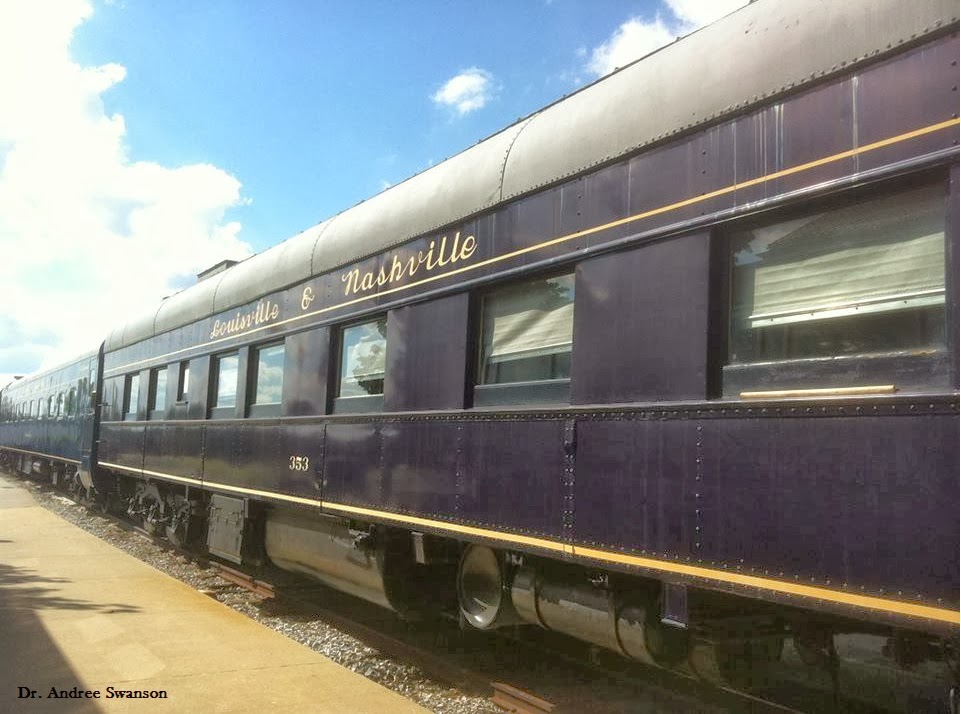Dr. Andree
Swanson, EdD
While
attending a conference in Bowling Green, Kentucky, my husband and I had the
opportunity to visit a lovely train museum.
The Historic Rail Park highlights the L&N line (Louisville and
Nashville Line) that ran from… you got it… Louisville, Kentucky to Nashville,
Tennessee.
Historic Rail Park:
According
to the website, you can see… “Step back
in time to the golden era of railroad passenger service as a Tour Guide takes
you behind the scenes of a Railway Post Office Car, Dining Car, Sleeper Car and
Office Car, with special occasion options to see the interior of a diesel
locomotive, a rare WWII Unit Hospital car, a Caboose and a rare 3-section
Segregation rail car”. Now, my husband
and I have been to several train and transportation museums, to include the United
States Army Transportation museum at Fort Eustis, Virginia. You always get to see the rail cars in the
yard, look in the window, but that was about it. At the Historic Rail Park, you can actually
go in the post office, dining, sleeper, and office car.
The
volunteer tour guide begins to explain how the cooks on the train were trying
to come up with something where they could make biscuits, cakes, etc. all from
the same batch of ingredients. He said
that the cooks on the train concocted
"Biscuit...The
word derives from the Latin words "bis" (twice) plus
"coctus" (cooked). In England,
a biscuit is what Americans usually call a cracker or cookie. The American
meaning for biscuit was first noted by John Palmer in his Journal of Travels in
the United States of North America, and in Lower Canada, (1818), and by 1828,
Webster defined the confection as "a composition of flour and butter, made
and baked in private families." In general,
usage such puffy leavened little breads were called "soda biscuits"
or "baking-soda biscuits," in contrast to the unleavened cracker
type.... Recipes for soda biscuits are found in every nineteenth-century
cookbook, especially with reference to the cookery of the South... The South is
also the home of the beaten biscuit, which was first mentioned in 1853...
In 1930
General Mills began selling a packaged quick biscuit mix called Bisquick that
was a great success and spawned many imitators."
---The Encyclopedia of American Food and Drink, John F. Mariani [Lebhar-Friedman:New York] 1999 (page 29)
Duncan Hines was from Bowling Green too
Duncan Hines was a
travelling salesman for years, riding the rails, and writing about restaurants
along the way. “He kept meticulous notes
on which establishments fed him well or provided him with a good night's sleep,
and wrote and self-published popular travel guides, offering readers his
tasteful advice on roadside diners and hotels. Hines' published his first cookbook in 1939,
and with annual updates, his guidebooks and cookbooks made him famous.”
(History Company)
If I heard the volunteer
guide correctly, he was behind the Biscquick brand, but like all good
things. Bisquick transitioned from
Duncan Hines
“In 1947 he was approached
by an entrepreneur, Roy H. Park, who wanted to put Hines' well-respected name
on kitchen products from pickles to appliances. Their company, Hines-Park
Foods, made both men millionaires, and the Duncan Hines brand name was sold to Procter & Gamble.
Hines died in 1959, and his guidebooks were discontinued after 1962. The
cookbooks are still in print, but to modern diners, Hines is just a brand of
cake mix (now owned by Pinnacle Foods). “ (History Company)
References


No comments:
Post a Comment